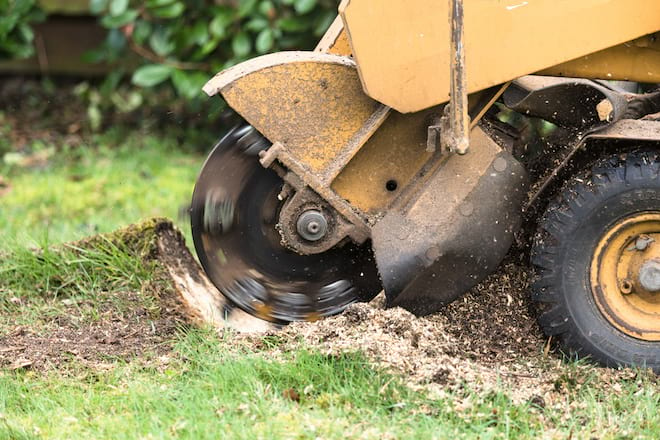How to Remove a Tree Stump: 5 Effective Methods for Homeowners


Tree stumps can be eye sores, take up valuable yard space, and even attract pests. While some homeowners might repurpose stumps as planters or garden features, others prefer to remove them entirely. Fortunately, there are several methods available for tree stump removal. Here are five techniques to get rid of tree stumps, from quick mechanical solutions to slower natural processes.
Grinding: Fast and Efficient

Stump grinding is one of the most popular and efficient methods for removing tree stumps. You’ll need a stump grinder with a high-speed rotating cutting wheel that chips away at the wood. You can get the job done with a chainsaw or stump grinder chainsaw attachment, but the process will take longer.
Keep in mind that using a chainsaw alone to grind down a large stump can destroy a small or old chainsaw. The cutting wheel chips away at the wood until the stump is below ground level, usually about 5 to 6 inches deep.
DIY or Professional?
The downside to stump grinding is that it can be costly. If you choose to DIY this project, start by digging around the stump to expose as much of it as possible. Then, cut it close to the ground using a chainsaw. Position the grinder over the stump and slowly move it from side to side. Continue grinding until the stump is about 5 to 6 inches below ground level and fill the hole with soil. Then you can replant grass or flowers, depending on your landscaping preferences.
While it’s possible to rent a stump grinder and do it yourself, I recommend hiring a professional for a large stump. Professionals have access to more powerful equipment and the expertise to use it safely and effectively. For a single large stump, professional services typically start at around $200, with costs increasing for multiple stumps.
Pulling: Fast but Risky

For smaller stumps less than 15 inches in diameter, pulling is often the easiest and most affordable removal option. To pull a small stump, you will need a farm, or handyman, a jack, two 2×4 boards, a heavy-duty chain, and a tractor or large four-wheel drive vehicle (for larger stumps).
Start by bolting the ends of the two 2x4s to the top of the jack to form a tripod. Then, position the tripod over the stump with the jack on one side and the 2x4s on the other. Wrap a high-quality chain or tow rope securely around the base of the stump. Then, hook the chain or rope onto the jack’s arm, and work the jack to gradually lift the stump. Attach the chain to a tractor (or four-wheel drive vehicle for larger stumps) and slowly drive forward to pull the stump out.
Pulling stumps is risky, so take safety precautions. The chain can snap and whip back, or the stump may come out suddenly and fly into the vehicle. Always use high-quality chains or tow ropes, and wear protective gear, including eyewear.
Burning: Time-Consuming but Enjoyable

Burning a tree stump is a slower process but works well for dry stumps. Be sure to check your local regulations and fire bans before attempting to burn a stump.
You’ll need to prepare the stump before you burn it. Check to make sure the stump is dry. Often, a year after cutting is ideal. Cover the stump for a week before you plan to burn it to keep it dry. When you’re ready to burn the stump, clear the area around it of flammable materials and reveal the full stump.
Next, drill two 8 to 10-inch-deep holes into the top of the stump. Pour several capfuls of kerosene (never gasoline) into each hole. Wait two weeks for the wood to absorb the kerosene, then surround the bottom of the stump with charcoal. Add firewood and kindling, then light the fire. Closely monitor the fire and call the fire department immediately if any complications occur.
When the fire runs out, thoroughly douse the area with water to ensure all embers are out.
Rotting: Low-Effort but Long-Term

Encouraging a stump to rot naturally is the least labor-intensive method but also the slowest. Rotting is ideal for homeowners who aren’t in a hurry and prefer a hands-off solution.
You’ll want to bury the stump completely with compost and keep the area moist by watering it. These steps will help to speed up the decomposition process. Turn the compost every two weeks to encourage fungal growth as well. The stump should be soft enough to remove with a shovel in 8 to 10 weeks.
Chemical Stump Removers
Commercial stump removers and high-nitrogen fertilizers can accelerate the rotting process.
Drill 8 to 10-inch holes throughout the stump, and pour the chemical remover or fertilizer into the holes. Water the stump and wait 6 to 8 weeks. These products break down the wood to a spongy consistency, making removal easier.
Using Epsom Salt
Epsom salt is another effective natural option and is more environmentally friendly and low-cost.
Mix one gallon of Epsom salt with two gallons of water. Pour the solution all over the stump and cover it with a plastic tarp to keep the wood dry. Reapply the solution every 2 to 3 weeks.
This method can take up to six months but is an organic option for those worried about treating their yard with harsh chemicals or being unable to burn their stumps.
Hiring Professional Stump Removal Services
For homeowners who prefer to leave the job to experts, professional stump removal services offer a hassle-free solution. These services have the equipment and expertise to remove stumps quickly and safely.
When choosing a reputable service, check for licensing and insurance, read customer reviews, and compare quotes. Make sure that you have a complete understanding of the methods being used by the experts in your yard.
Professional stump removal cost varies based on the stump size, the number of stumps, location, accessibility, removal method, and as always, the local market rates.
Final Thoughts About Tree Stump Removal
Removing a tree stump can significantly improve the appearance and functionality of a yard. While each method has its pros and cons, homeowners can choose the approach that best fits their timeline, budget, and effort level. Grinding offers a quick solution but requires specialized equipment, while natural rotting is low-effort but time-consuming. Burning can be enjoyable for those who like outdoor activities, and pulling works well for smaller stumps. For those preferring a hands-off approach, professional services provide convenience and expertise.
Regardless of the chosen method, safety should always be the top priority. If you don’t feel you can safely remove the stump, call a professional for help.






Leave a Reply